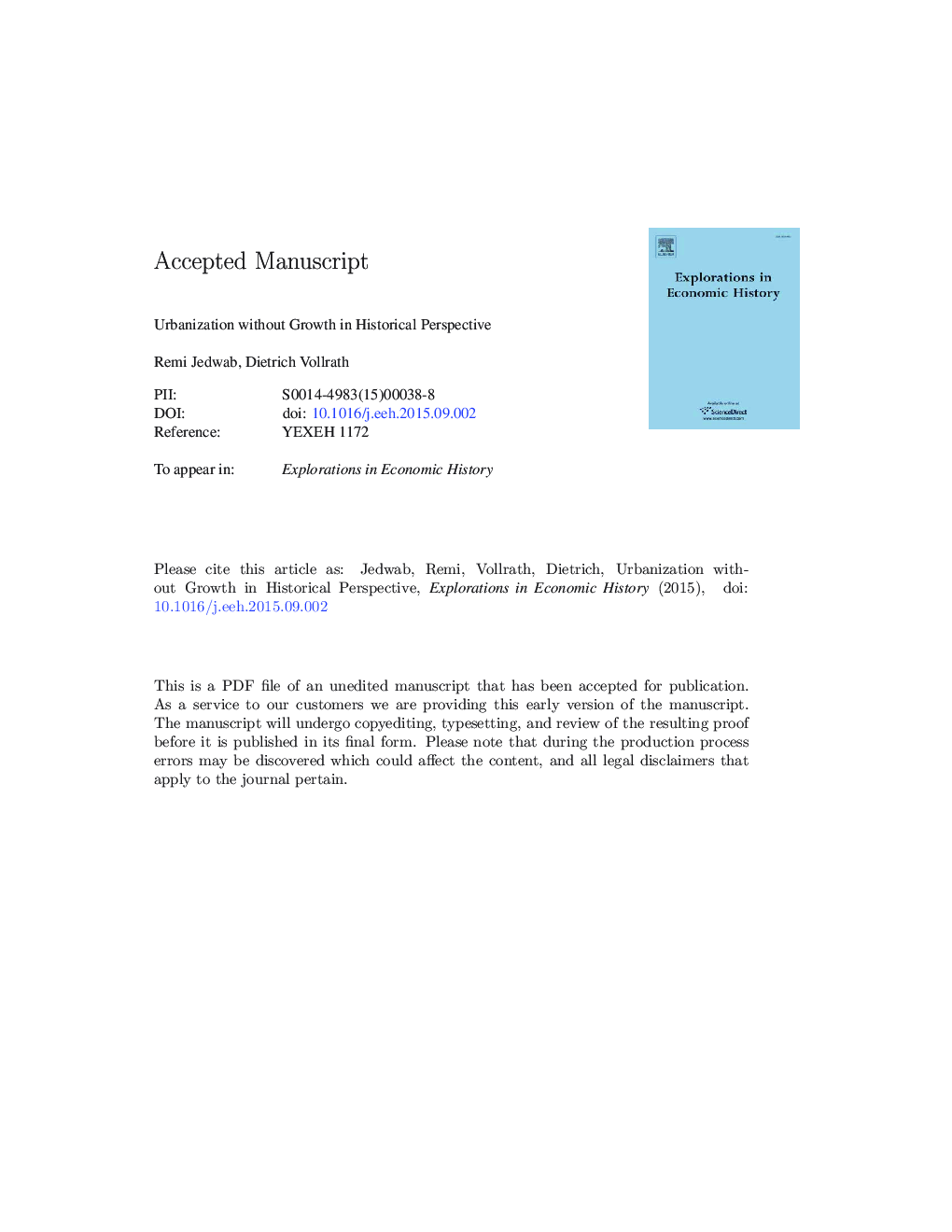| کد مقاله | کد نشریه | سال انتشار | مقاله انگلیسی | نسخه تمام متن |
|---|---|---|---|---|
| 5068714 | 1476969 | 2015 | 34 صفحه PDF | دانلود رایگان |
عنوان انگلیسی مقاله ISI
Urbanization without growth in historical perspective
ترجمه فارسی عنوان
شهرنشینی بدون رشد در منظر تاریخی
دانلود مقاله + سفارش ترجمه
دانلود مقاله ISI انگلیسی
رایگان برای ایرانیان
کلمات کلیدی
ترجمه چکیده
جهان در هر سطح درآمد بیشتر و بیشتر شهری می شود و تعداد مگا در کشورهای در حال توسعه افزایش قابل توجهی دارد. این امر باعث شده است که محققان بر این باورند که توسعه و شهرنشینی همواره در هم فضا و یا در طول زمان همبستگی وجود ندارد. در این مقاله، از میان داده های تاریخی در سطح کشور و سطح شهر طی پنج قرن بین سال های 1500 تا 2010، به منظور بازبینی موضوع «شهرنشینی بدون رشد» استفاده می شود. (فای و اپال، 2000). به طور خاص، ما ابتدا میبایستیم که اگرچه در هر سال، شهرنشینی و درآمد همواره همبستگی زیادی با هم دارند، اما در سال 2010، میزان شهری 25 تا 30 درصد بالاتر از 1500 در هر سطح درآمد سرانه است. دوم، در حالی که در گذشته، این تغییر در نرخ های شهری در دم بالا از توزیع درآمد، به عنوان مثال برای کشورهای ثروتمند بیشتر قابل توجه است، در حال حاضر به خصوص در دم پایین تر، به عنوان مثال برای کشورهای فقیر دیده می شود. سوم، این الگوهای نشان می دهد که عوامل مختلف ممکن است تغییر در زمان های مختلف را توضیح دهد. ما از بحث در مورد این عوامل به عنوان فرصتی برای ارائه یک نظرسنجی از ادبیات استفاده می کنیم و دانش ما را در مورد چگونگی روند روند شهرسازی در طول زمان خلاصه می کنیم.
موضوعات مرتبط
علوم انسانی و اجتماعی
علوم انسانی و هنر
تاریخ
چکیده انگلیسی
The world is becoming more and more urbanized at every income level, and there has been a dramatic increase in the number of mega-cities in the developing world. This has led scholars to believe that development and urbanization are not always correlated, either across space or over time. In this paper, we use historical data at both the country level and city level over the five centuries between 1500-2010 to revisit the topic of “urbanization without growth” (Fay and Opal, 2000). In particular, we first establish that, although urbanization and income remain highly correlated within any given year, urbanization is 25-30 percentage points higher in 2010 than in 1500 at every level of income per capita. Second, while historically this shift in urbanization rates was more noticeable at the upper tail of the income distribution, i.e. for richer countries, it is now particularly visible at the lower tail, i.e. for poorer countries. Third, these patterns suggest that different factors may have explained the shift in different periods of time. We use the discussion of these factors as an opportunity to provide a survey of the literature and summarize our knowledge of what drives the urbanization process over time.
ناشر
Database: Elsevier - ScienceDirect (ساینس دایرکت)
Journal: Explorations in Economic History - Volume 58, October 2015, Pages 1-21
Journal: Explorations in Economic History - Volume 58, October 2015, Pages 1-21
نویسندگان
Remi Jedwab, Dietrich Vollrath,
